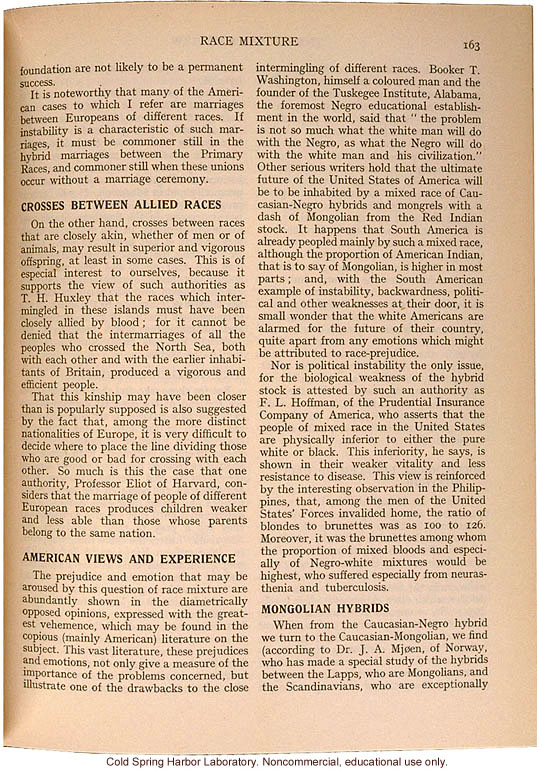Race Mixture 163
foundation are not likely to be a permanent success.
It is noteworthy that many of the American cases to which I refer are marriages between Europeans of different races. If instability is a characteristic of such marriages, it must be commoner still in the hybrid marriages between the Primary Races, and commoner still when these unions occur without a marriage ceremony.
Crosses Between Allied Races
On the other hand, crosses between races that are closely akin, whether of men or of animals, may result in superior and vigorous offspring, at least in some cases. This is of especial interest to ourselves, because it supports the view of such authorities as T. H. Huxley that the races which intermingled in these islands must have been closely allied by blood; for it cannot be denied that the intermarriages of all the peoples who crossed the North Sea, both with each other and with the earlier inhabitants of Britain, produced a vigorous and efficient people.
That this kinship may have been closer than is popularly supposed is also suggested by the fact that, among the more distinct nationalities of Europe, it is very difficult to decide where to place the line dividing those who are good or bad for crossing with each other. So much is this the case that one authority, Professor Eliot of Harvard, considers that the marriage of people of different European races produces children weaker and less able than those whose parents belong to the same nation.
American Views and Experience
The prejudice and emotion that may be aroused by this question of race mixture are abundantly shown in the diametrically opposed opinions, espressed with the greatest vehemence, which may be found in the copious (mainly American) literature on the subject. This vast literature, these prejudices and emotions, not only give a measure of the importance of the problems concerned, but illustrate one of the drawbacks to the close intermingling of different races. Booker T. Washington, himself a coloured man and the founder of the Tuskegee Institute, Alabama, the foremost Negro educational establishment in the world, said that "the problem is not so much what the white man will do with the Negro, as what the Negro will do with the white man and his civilization." Other serious writers hold that the ultimate future of the United States of America will be to be inhabited by a mixed race of Caucasian-Negro hybrids and mongrels with a dash of Mongolian from the Red Indian stock. It happens that South America is already peopled mainly by such a mixed race, although the proportion of American Indian, that is to say of Mongolian, is higher in most parts; and, with the South American example of instability, backwardness, political and other weaknesses at their door, it is small wonder that the white Americans are alarmed for the future of their country, quite apart from any emotions which might be attributed to race-prejudice.
Nor is political instability the only issue, for the biological weakness of the hybrid stock is attested by such an authority as F. L. Hoffman, of the Prudential Insurance Company of America, who asserts that the people of mixed race in the United States are physically inferior to either the pure white or black. This inferiority, he says, is shown in their weaker vitality and less resistance to disease. This view is reinforced by the interesting observation in the Philippines, that, among the men of the United States' Forces invalided home, the ratio of blondes to brunettes was as 100 to 126. Moreover, it was the brunettes among whom the proportion of mixed bloods and especially of Negro-white mixtures would be highest, who suffered especially from neurasthenia and tuberculosis.
Mongolian Hybrids
When from the Caucasian-Negro hybrid we turn to the Caucasian-Mongolian, we find (according to Dr. J. A. Mj[owith slash through it)en, of Norway, who has made a special study of the hybrids between the Lapps, who are Mongolians, and the Scandinavians, who are exceptionally
[end]


